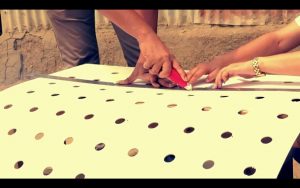You may have seen many air coolers that use a simple electric fan and cold water or ice to make an air conditioner. Those are cheap to make, but maintaining/running them is a hassle. Instead, why not make an A/C that doesn’t use any ice or electric fan to provide you with cool air. Sure, if you want, you can modify it to make use of ice and fans and make it even better. Is it magic? Kind of… it’s actually some cool science! [enough of the puns already 😉 ].*(Actually sorry for that! See end of the article!)
Try blowing air on your hand with a wide mouth, then try it with pursed lips. Notice any difference? This is the principle we’ll be using for our cooler. This eco-cooler that we are about to make will work better in a windy place. Unfortunately, if there is no wind then you’ll have to rely on other methods.
You can also download a PDF (links below) and watch a video (after the steps).
Gather as many used soft-drink and water bottles. The bigger the size difference between the body and the rim of the bottle, the better. 1.5L and 2.0L bottles are ideal.
Step 2
 Measure the window you want to make the Eco-Cooler for. And cut a sturdy 2mm medium density board or similar sturdy board in the same size.
Measure the window you want to make the Eco-Cooler for. And cut a sturdy 2mm medium density board or similar sturdy board in the same size.
Make sure to keep atleast half an inch flushed around all the sides. This will ensure you have the perfect sized Eco-Cooler.
Cut holes in the board according to the measurement of the rim of the bottle. Make sure the cuts are spaced out according to the body size of the bottles.
Using a pair of scissors, cut the bottle in half – along the body of the bottle.
Cut away the top of the bottle cap. This will help fix the bottle into the board.
Pushing the cut bottle from the outer side of the board, twist the cap from the inner side and tighten it, to keep the bottle in its place. Repeat for the remaining bottles and fix the Eco-Cooler from the outer side of the window.


You can also download the PDF instructions (which includes a scale drawing for 2L bottles) from link 1 or link 2.
Watch the video below of how its helping small communities and villages in Bangladesh, but before that, do you know why it works? Its simple science actually
 The neck of plastic bottles, helps to compress the air. As the hot air is pushed towards the rim (just as it exits the bottle), it starts expanding. This rapid expansion of the warm air cools the air down. It has been noted that depending on the conditions, this air can be up to 5ºC cooler. For more on the science, check out this link.
The neck of plastic bottles, helps to compress the air. As the hot air is pushed towards the rim (just as it exits the bottle), it starts expanding. This rapid expansion of the warm air cools the air down. It has been noted that depending on the conditions, this air can be up to 5ºC cooler. For more on the science, check out this link.
*Explaination: Actually we did see a reduction in temperatures, but the reasons in this method and article are not why it happened. This device is almost useless and the science doesn’t add up. The only reason we noticed a reduction in daytime temperature was probably due to the reduced sunlight that entered the room (because of the holes, the wind wasn’t completely blocked). Yes, air does absorb heat when it expands immediately but in this device, the both the process are happening, compression and expansion. The heat has nowhere to go, then the temperature is uneffected due to this. 😐 Sorry for getting your hopes so high! We regret that we wanted this so be so true that we also believed in it for a while. Thanks to some of your comments on reddit and YouTube, we were able to rectify our mistake!





















You’ve got it backwards. Air is expanding in the bottleneck; it’s compressed again when it exits and slows down. Think of a wing: as the air flows over the rounded top, its speed increases and the pressure decreases drawing the wing upward. The same thing is happening in the bottleneck. A better example is a converging nozzle. I know this seems counter-intuitive but you should talk to someone who understands gas dynamics to get the true explanation.
So the air could become cooler in the bottleneck, but then heats up again when it exits. Nothing’s perfect, though. You might be able to get the losses to balance in favor of the cooling effect, probably not. Because the nozzle itself should be getting cooler, another possibility might be to make the nozzle out of thin metal attached to a grid and pass air through that into the hut. Don’t use the air that passes through the nozzle; keep that outside.
You are right, we completely messed this one up!